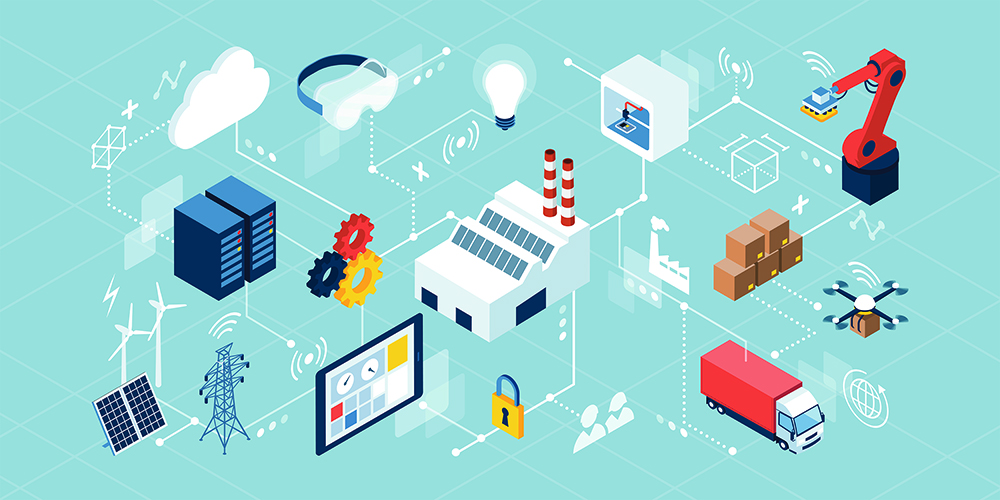Feature
The Internet of Things (IoT): a beginner's guide
Embark on a journey to discover how ordinary objects weave into a network of smart devices, elevating efficiency, convenience, and connectivity. By Oumar Fofana.

The Internet of Things (IoT) is a network where devices connect, exchange data with each other, and interact with the cloud. Credit: elenabsl via Shutterstock
In an era dominated by technological advancements, the term "Internet of Things" (IoT) has become increasingly prevalent.
But what exactly is IoT, and why does it matter?
This primer aims to demystify the concept for readers who are new to the topic, providing a comprehensive overview, examples, and illustrations to help you grasp the fundamentals of this transformative technology.
Understanding the basics
At its core, the Internet of Things refers to the interconnectedness of everyday objects through the internet.
These objects, often embedded with sensors and other technologies, can collect and exchange data, creating a network where physical devices communicate seamlessly with each other.
In simpler terms, IoT enables objects to connect and share information, making our environments smarter and more responsive.
Key components of IoT
- Sensors and actuators: Central to IoT are sensors, which gather data from the physical world, and actuators, which perform actions based on that data.
For instance, a smart thermostat uses sensors to detect room temperature and actuators to adjust the heating or cooling accordingly. - Connectivity: For devices to communicate, they need to be connected. This can be achieved through various means, such as Wi-Fi, Bluetooth, or cellular networks.
The choice of connectivity depends on the specific requirements of the IoT application. - Data processing: Collected data needs to be processed to extract meaningful insights. Cloud computing and edge computing play crucial roles in managing and analysing the vast amounts of information generated by IoT devices.
- User Interface: IoT often involves a user interface, allowing individuals to monitor and control connected devices. This interface can be a smartphone app, a web portal, or other interactive platforms.
Examples of IoT in action
- Smart home devices: Devices like smart thermostats, lighting systems, and security cameras are part of IoT, allowing homeowners to control and monitor their homes remotely.
- Healthcare applications: Wearable fitness trackers, smart glucose monitors, and remote patient monitoring systems exemplify IoT in healthcare, providing real-time data to both patients and healthcare professionals.
- Smart cities: Cities are becoming smarter by deploying IoT solutions for traffic management, waste management, and environmental monitoring. Smart streetlights that adjust brightness based on activity are a prime example.
- Industrial IoT (IIoT): In industrial settings, IoT is revolutionising operations through predictive maintenance, asset tracking, and real-time monitoring of equipment. This enhances efficiency and reduces downtime.
Benefits and challenges
Benefits:
- Efficiency: IoT enhances efficiency by automating processes and optimising resource usage.
- Convenience: Connected devices offer convenience through remote monitoring and control.
- Data Insights: The data generated by IoT devices provides valuable insights for better decision-making.
Challenges:
- Security Concerns: The interconnected nature of IoT raises concerns about data privacy and cybersecurity.
- Interoperability: Ensuring seamless communication among diverse devices from different manufacturers is a challenge.
- Scalability: As IoT ecosystems grow, scalability becomes crucial to handle the increasing volume of data and devices.
The takeaway
The Internet of Things is a transformative force reshaping how we interact with the world. From smart homes to connected cities and industrial applications, IoT is becoming an integral part of our daily lives.
Whether you're a tech enthusiast or a curious bystander, understanding the basics of IoT is crucial for grasping the evolving landscape of our interconnected world. This understanding is also essential for navigating the increasingly connected and intelligent landscape of the future.
Why IoT matters for the packaging industry
In the dynamic landscape of the packaging industry, grasping the intricacies of the Internet of Things (IoT) is not just beneficial but transformative.
IoT introduces a new era of intelligent packaging, where each box, bottle, or container becomes a data node in a vast network. For packaging professionals, this means unprecedented visibility into the supply chain, with real-time tracking and monitoring of products from manufacturing to delivery.
Imagine packages that can communicate their condition, ensuring the integrity of perishable goods or alerting stakeholders to potential damage in transit. The integration of IoT in packaging not only enhances product safety but also streamlines logistics, reduces waste, and optimises inventory management.
Ultimately, embracing IoT technology is not merely a choice for the packaging industry; it's a strategic imperative in an era where efficiency and sustainability are paramount.
As we navigate the IoT landscape, it becomes evident that its implications extend far beyond the digital realm, touching every aspect of how we package, deliver, and experience products.